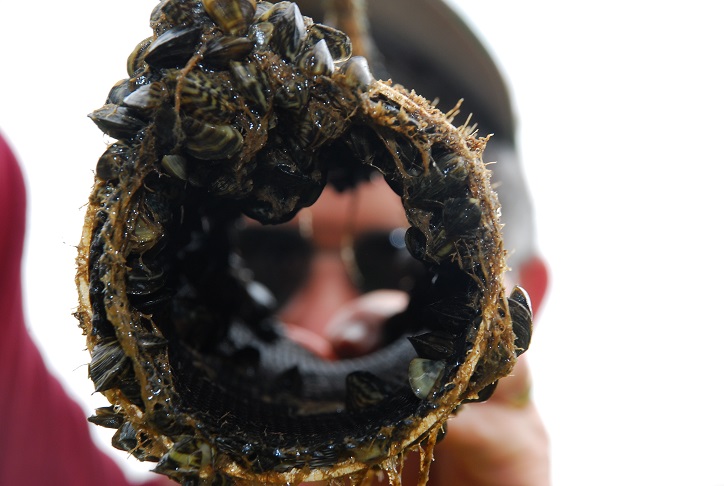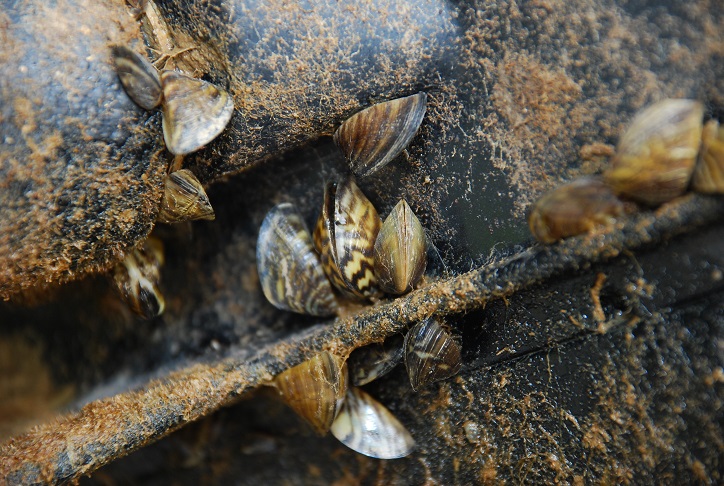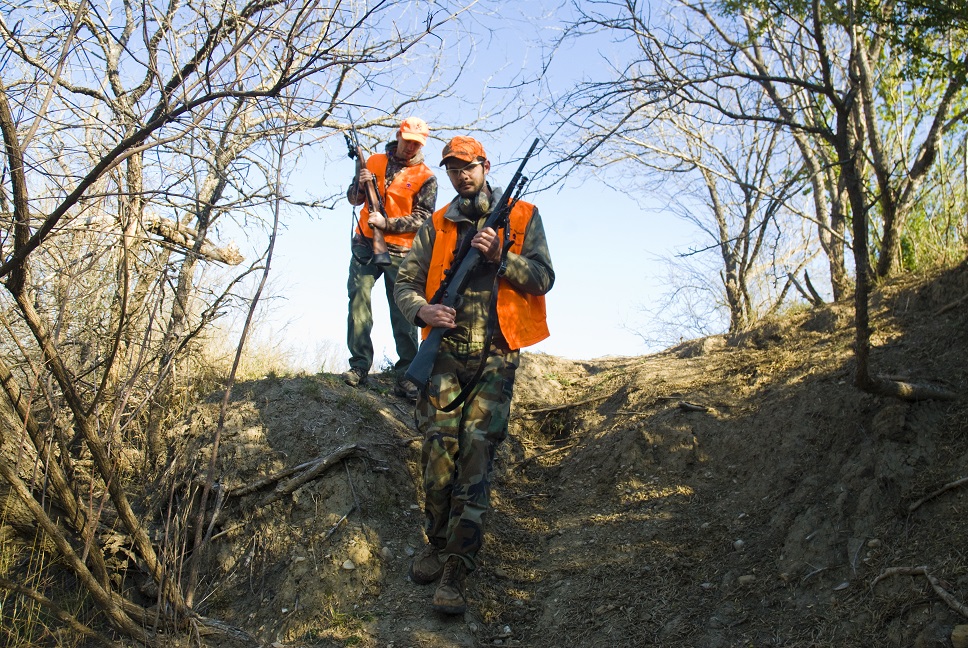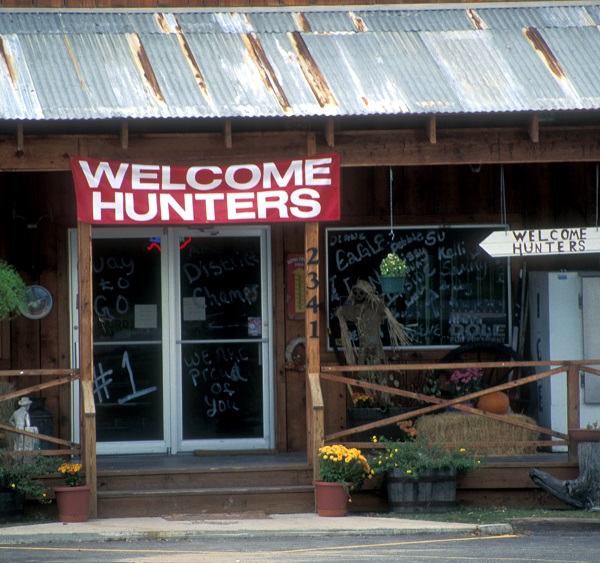November 7th, 2013

Zebra mussels on water intake pipe.
This is Passport to Texas
Zebra Mussels, originally from Eastern Europe, ended up in the Great Lakes in the late 1980s in the ballast of ships. Since then…
05— They’ve been pretty steadily moving across much of the eastern and central portion of the United States.
Inland fisheries biologist Brian Van Zee says zebra mussels arrived in Lake Texoma in 2009; now they occupy waters in north and north central Texas – most recently in Lake Belton.
10—They’re primarily moved from water body to water body by boaters, who don’t take the time to clean, drain and dry from an infested lake to a non-infested lake.
Zebra mussels attach to hard surfaces, including rocks, docks, boats and even other animals. As filter feeders, they impact the aquatic food chain, and clog water intake pipes of municipal utility districts, causing significant increases in maintenance and operational costs. So boaters: clean, drain and dry.
20—On a general rule of thumb, we recommend boaters dry their boats for a week before they go from one lake to the next, if at all possible. If they just pull the plug out of the bottom of the boat, lower the engines down, and make sure there’s no water in them, and make sure the live wells are empty, and open those compartments up and let them dry in between going from one lake to the next, you really reduce that risk of moving zebra mussels from one lake to another.
The Wildlife and Sport Fish Restoration Program supports our series. For Texas Parks and Wildlife…I’m Cecilia Nasti.
Posted in Conservation | Comments Off on Invasives: Impact of Zebra Mussels
November 6th, 2013

Zebra Mussels
This is Passport to Texas
Texas Mussel Watch volunteers collect data on rare and at risk mussel species.
20— Texas Mussel Watch Volunteers get out there in water bodies in their local communities, and they record all of the freshwater mussels that they observe at that site. And it takes a really special person to do that, because they’ve got to get in the water, muck around in the mud…. They’re just really special volunteers.
Program coordinator, Marsha May said during routine monitoring, one of her volunteers made an important discovery.
30— Near the end of September, one of my volunteers sent me an email with fabulous photographs of a species she found in Lake Belton attached to another native mussel, and really to me it looked to me like Zebra Mussels. I wanted to be absolutely sure, because that’s not something you take lightly. I sent the email with the photographs on to Inland Fisheries and they sent some folks out to Lake Belton and confirmed that they were Zebra Mussels.
Zebra mussels are a highly destructive non-native invasive species, and we’ll learn more about them tomorrow.
The Wildlife and Sport Fish Restoration Program supports our series. For Texas Parks and Wildlife…I’m Cecilia Nasti.
Posted in Uncategorized | Comments Off on Wildlife/Citizen Science: Helping Biologists
November 5th, 2013

Horned lizard
This is Passport to Texas
Texas Nature Tracker is a program designed to help citizens learn how to monitor and share data on rare species around the state.
10— This citizen science program is a great one to get citizens involved in collecting data on species that we don’t have enough biologists to actually do the work.
Biologist, Marsha May, coordinates the Nature Tracker Program for Parks and Wildlife. Depending on their interests, volunteers receive training for one or more targeted species…
13— Texas whooping cranes, bumblebees, frogs and toads, the box turtle survey, coastal fisheries has one for tarpon, Texas horned lizards, and Texas mussel watch.
Once trained, volunteers monitor the species and report back to May with their data, which in turn provides value to state biologists.
09— The value comes from not having enough boots on the ground to get out there to find out what’s going on with populations throughout the state.
Tomorrow, we tell you about one Nature Tracker volunteer who discovered a destructive invasive species in a Texas Lake.
05—Well, that particular one that you’re talking about is the zebra mussel.
That’s our show for today… Funding provided in part by Ram Trucks. Guts. Glory. Ram
For Texas Parks and Wildlife…I’m Cecilia Nasti.
Posted in Conservation, Education | Comments Off on Wildlife/Citizen Science: Texas Nature Trackers
November 4th, 2013

Deer hunters in the field.
This is Passport to Texas
Hunting is not only a tradition in Texas—it is also a commitment to wildlife conservation.
16—Hunters started to see declines in certain game species populations and habitat. And realized if they want to enjoy perusing game (it doesn’t even have be for harvest), just if they want to see that perpetuated so their kids, and future generations can enjoy that, they realized they needed to protect it.
Alan Cain, Texas whitetail deer program leader, says in the early 20th century, hunters chose to conserve wildlife through taxation.
22—In 1937, you had the Sport Fish and Wildlife Restoration Act – called the Pittman-Robertson Act – [signed into law]. Basically it’s a user pay system where the hunters said, ‘okay, we’re going to tax ourselves to help pay for wildlife conservation.’ And that’s been a huge success. In my opinion, that’s why North America has the best wildlife management conservation model in the world – because hunters pay for that.
Hunters pay with the licenses they buy, and the excise taxes levied on firearms, ammunition and other equipment, which goes directly to fund conservation.
11— And then the second part of that is that hunters not only play a role in funding conservation that benefits everybody, but they also play a role in managing deer populations out there.
By removing deer from the landscape, they help keep habitat in balance for all wildlife.
The Wildlife and Sport Fish Restoration Program supports our series and funds whitetail research in Texas.
For Texas Parks and Wildlife…I’m Cecilia Nasti.
Posted in Hunting | Comments Off on Hunting: Hunters as Conservationists
November 1st, 2013

Hunting provides economic opportunity in small Texas towns.
This is Passport to Texas
The first weekend in November is typically opening weekend of deer season in Texas.
04—This year, 2013 the deer hunting prospects look really good.
Alan Cain is Texas whitetail deer program leader at Parks and Wildlife.
11—The reports I’m hearing from landowners out there across the state is that the deer fat, are in good body condition, and antler quality appears to be pretty good. So hunters should have a good opportunity out there.
September and October brought rainfall across the state, which could make deer hunting more of a challenge.
36—That’s going to cause things to green up, obviously. So, the deer may not be hitting the corn feeder because they have not seen some of this green stuff in a couple of months. And so, they may go out there and find some tender weeds to chew on, or some brush out there, or the different browse, shrub top species; they’ll eat on those and may not come to that corn feeder where hunters traditionally sit.
Alan Cain says don’t lose heart – the deer are there – you’ll need to change your hunting strategy to bag them.
11—You want to sit on a trail that’s leading from a bedding to a feeding area. Or, look for locations where deer are concentrating; maybe it’s where the oaks are dropping lots of acorns. So, I suspect deer will be on those, too.
The Wildlife and Sport Fish Restoration program Supports our series…For Texas Parks and Wildlife…I’m Cecilia Nasti.
Posted in Hunting | Comments Off on Hunting: 2013-14 Deer Season Forecast







 Passport to Texas is a
Passport to Texas is a  Passport to Texas is made available by:
Passport to Texas is made available by: